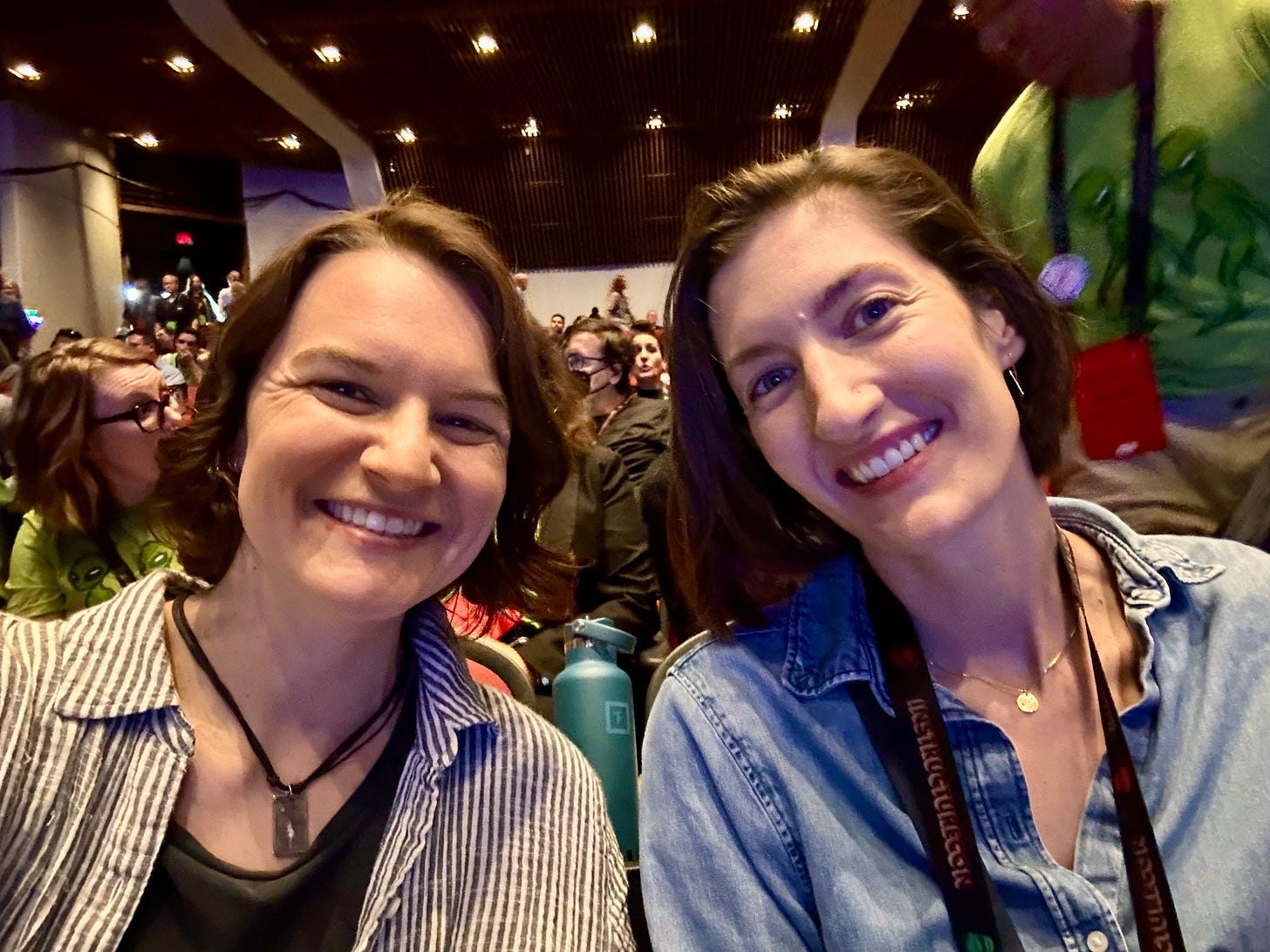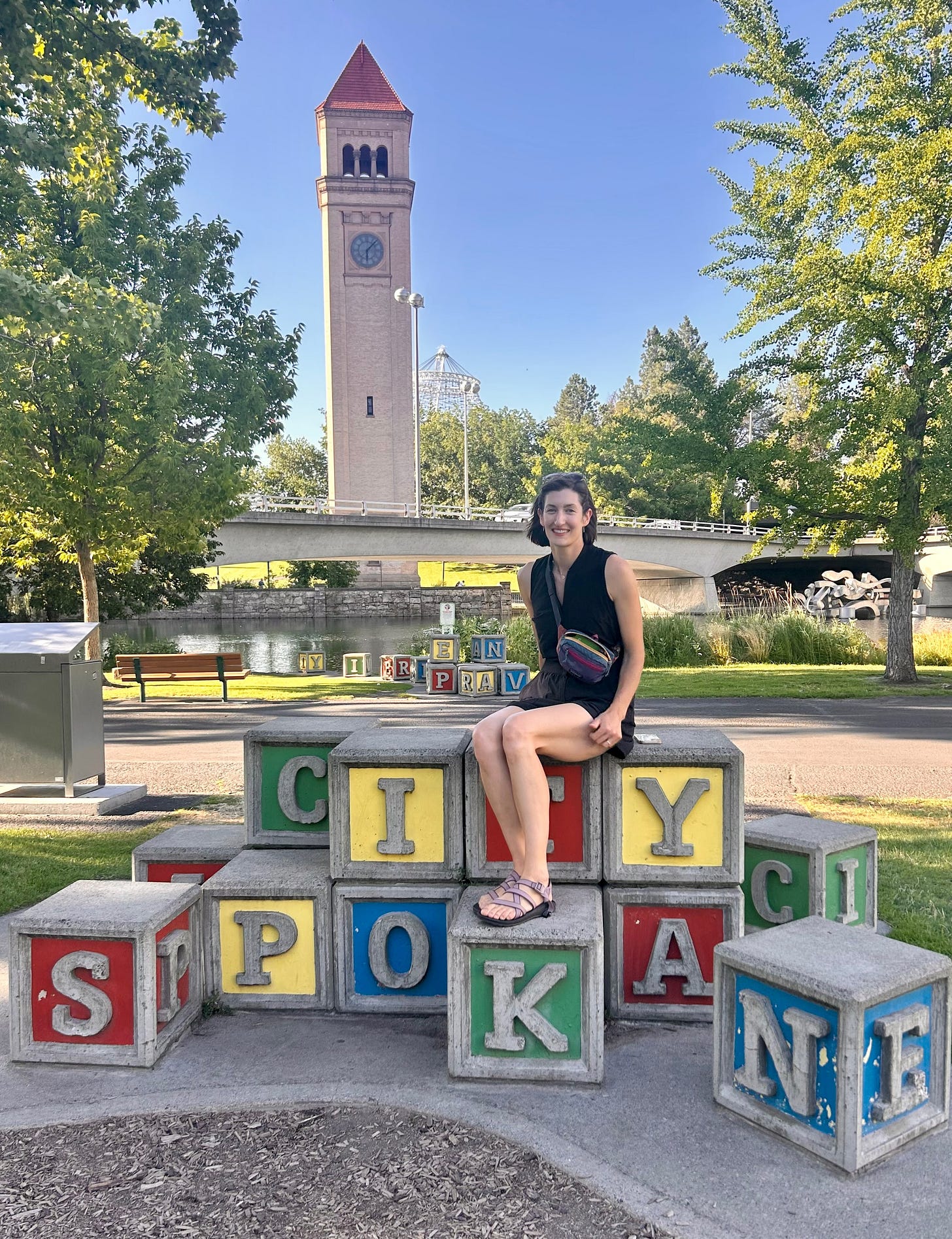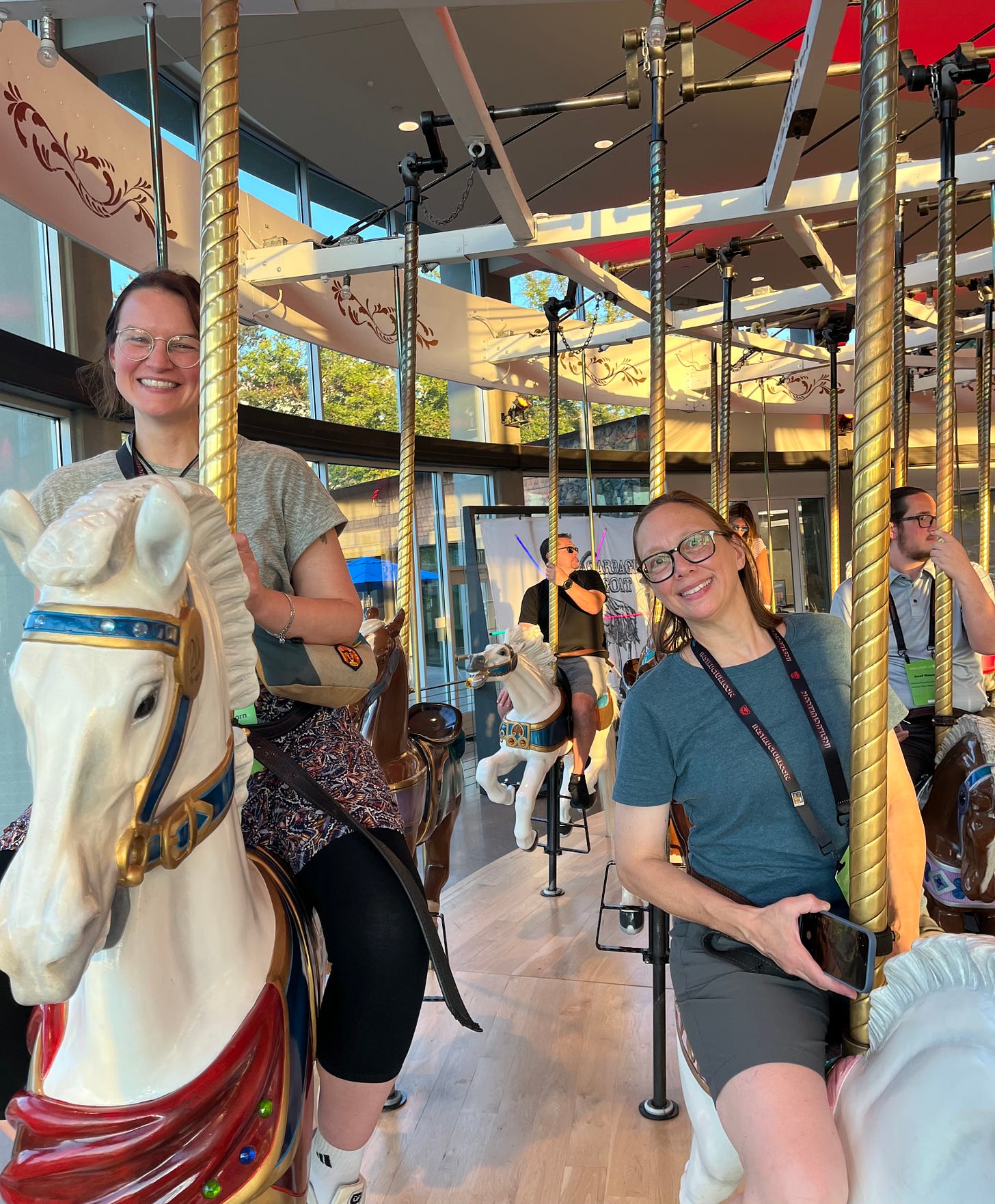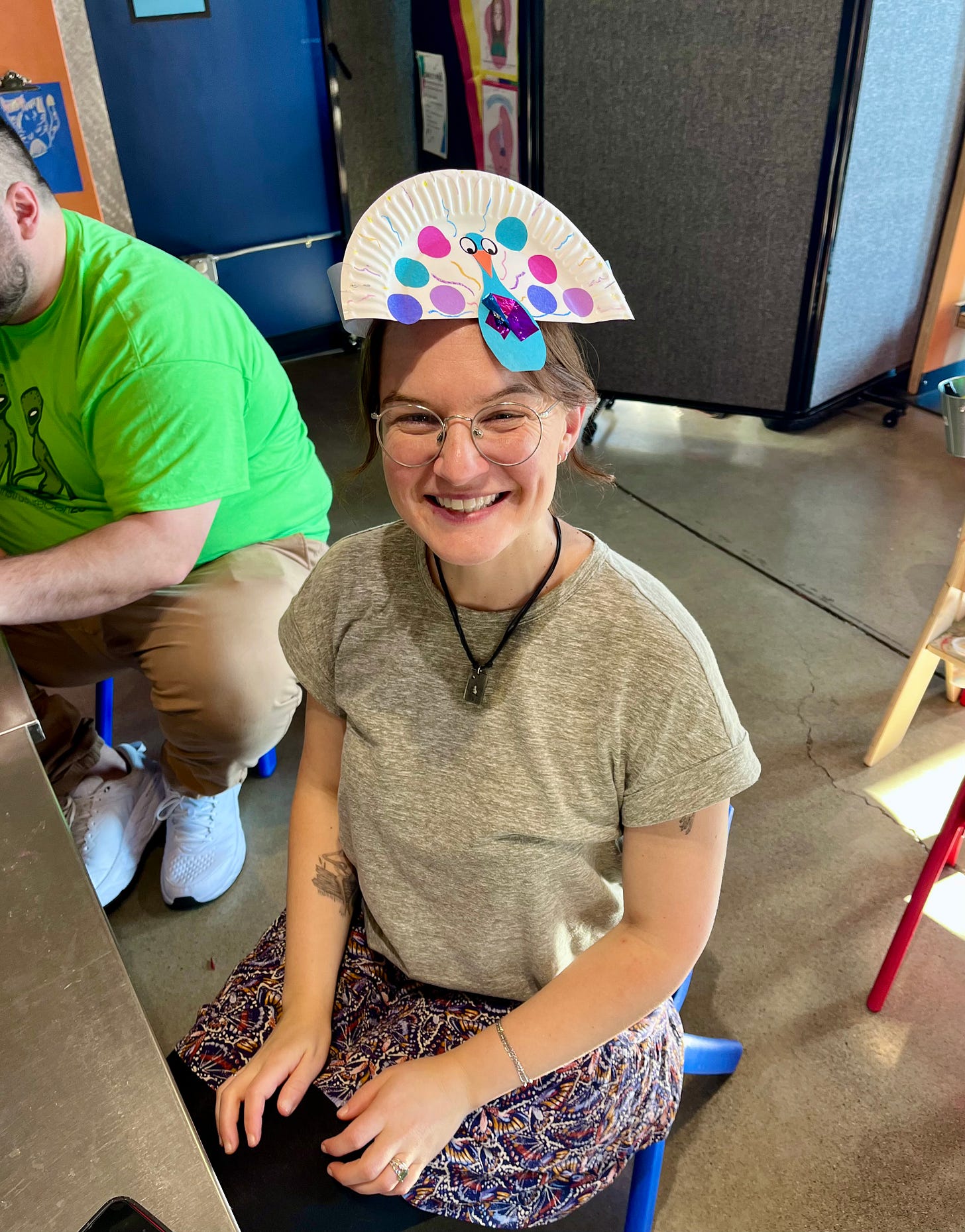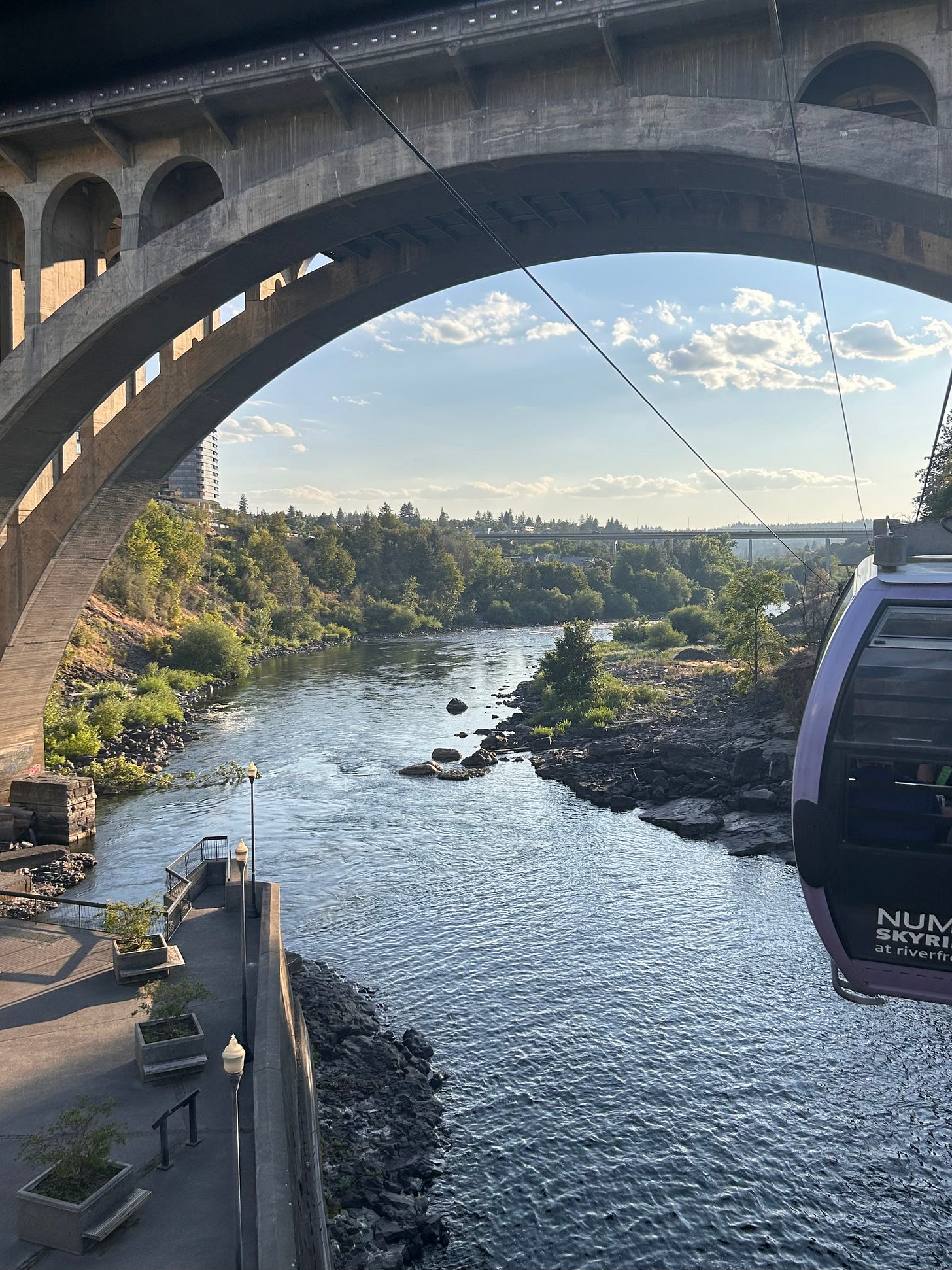InstructureCon Recap: Demystifying the Ed Tech Conference Experience
The Vibe Check You Didn’t Know You Needed
At the end of the July, the iLearnNH training team made their way to Spokane, WA to attend InstructureCon 2025. We showed up with curiosity, a few too many sweaters (or not enough, depending on who you ask), and a hope that we would leave feeling a little more connected and inspired. Spoiler: we did!
To make sense of everything we saw, felt, and learned, we turned to a familiar tool, ChatGPT, and asked it to interview us about the experience. What follows is that interview—a mix of reflections, takeaways, and the little moments that stuck with us.
Whether you’ve been to a big ed tech conference before or you’re wondering what they’re really like, we hope this gives you a peek into the experience—and maybe even a few ideas for your own professional learning along the way.
Expectation vs Reality
What did you think this conference would be like beforehand? Was it your first one?
Becca: I attended InstructureCon two years ago in Aurora, Colorado, so I assumed it would be similar: big conference center, lots of sessions and opportunities to chat with educators, and a few knock-out events. But mostly, I expected it to be cold. There’s something so bizarre about going to a big event in the thick of summer and wishing you brought a hat and mittens.
Lucy: This was my very first InstructureCon, and I really didn’t know what to expect! My only frame of reference for an ed tech conference was New Hampshire’s Christa McAuliffe Technology Conference—much smaller and far less corporate. I definitely hadn’t considered just how big InstructureCon would be—over 3,000 attendees!—or what a major production the whole event was.
How did your expectations compare with reality once you were there?
Becca: It wasn’t cold! I mean, the space was still air conditioned to the gills, but we weren’t confined to a suburban conference center without a car. I loved the location. The ability to walk around Spokane, interact with the local community, and reset in the gorgeous summer air made all the difference.
Lucy: I was honestly surprised by how fun the conference was! Instructure didn’t hold back on the parties, the decorations, the swag, or the energy. I respected that they seemed to fully understand the assignment: create an energizing, inspiring atmosphere that honors educators’ need to unwind over the summer while also keeping the focus on meaningful, collaborative professional learning.
What was the moment you knew you were officially "at a conference" (e.g. badge pickup chaos, coffee line bonding)?
Becca: Settling in for the Opening Keynote was magical. Instructure built a set—a whole set!—to lean into the otherworldly theme. And once Baratunde Thurston started to speak, I was hooked. He was both thoughtful and thought-provoking, and I couldn’t wait to scribble down my ideas afterwards. To me, that’s the sign of a good conference: it fills you with new questions, ideas, energy, and perspectives. You leave wanting to learn more.
Lucy: I felt the shift even before we arrived in Spokane. During our layover in Denver, Becca and I started noticing lots of people wearing edtech-related t-shirts. It slowly clicked: almost everyone on our flight was headed to InstructureCon, too. That’s when the scale of the conference really started to sink in.
What did you pack that turned out to be totally unnecessary? What do you wish you'd brought?
Becca: I’m telling you… I was really fixated on the idea that it would be cold. I brought four warm layers in anticipation of aggressive air conditioning, and I ended up needing—maybe two? I didn’t plan on bringing back so much (delightful) swag, so I could have used that space in my suitcase on the return trip! There was some epic packing Jenga on the last night.
Lucy: Okay, I did not get the memo about the air conditioning, and I didn’t pack enough layers! And yet I still had trouble fitting all the swag and souvenirs in my suitcase. (Thankfully, some of that swag included a sweatshirt and a blanket—almost like they knew we’d be freezing!)
The Sessions: Hits, Misses, and Head-Scratchers
Which session surprised you the most (in a good or bad way)?
Becca: I went to one session called, “From Acne to Achievement: Canvas in the Middle School,” and it was fantastic. Maria Tenny, a Digital learning Specialist from the Rockwood School District in Missouri, gave an energized, inspiring glimpse into how her school uses Canvas to support the middle school experience.
One approach they use is creating a Canvas Readiness Course to build comfort and confidence for fifth graders and new students. Kids work through a gamified course independently and then get a (real) reward sticker on the first day of school if they complete it. It’s so cool—the course includes not just how to submit Canvas assignments and use Gmail, but also a virtual simulation for how to open a locker. I remember being so scared about lockers! It’s such a kind, thoughtful way to get students used to Canvas while helping to address their fears.
Lucy: One of the best sessions I attended was called “Comprehensively Addressing Student AI Use in Online Learning.” The room was packed—standing room only. People were clearly hungry for this conversation. The presenter, Mike Agostinelli from Montana Digital Academy (a K–12 school that offers asynchronous online learning), shared a realistic and innovative approach to integrating AI into student learning.
What stood out was how grounded the session felt. It offered an interesting contrast to the main stage keynotes about AI—talks that, while necessary, felt somewhat disconnected from the day-to-day realities educators face. This session was honest, practical, and deeply relevant—and the educators in the room ate it up.
Were there any buzzwords that popped up everywhere?
Becca: I’m sure this will surprise you, but AI was everywhere. AI AI AI AI AI AI… everywhere.
Lucy: There was also a lot of talk about lifelong learning— for both the educators in attendance, but also how Instructure tools can help people keep learning well after graduation. It fit right in with the conversations about AI and the future of work, and especially with the launch of Canvas Career, which is a new tool that support career-connected learning beyond the classroom.
Did you find any real gems—an idea, tool, or presenter—that shifted your thinking?
Becca: I’m still thinking about Baratunde Thurston’s keynote. One idea has really stuck with me: “The system that’s falling apart is not worthy of defense.”
Something is dying right now—there’s a technical and social evolution that’s moving faster than our minds and bodies can handle—but Thurston warned of nostalgia, especially in education. Yes, the Department of Education has collapsed and that is both a loss and a transition, but is it truly worthy of our grief? It’s a great question, and one that I’ve been thinking about a lot: What do we want to build now, and how can we make sure as many voices as possible are included in the rebirth?
Lucy: I agree—Baratunde Thurston’s was incredible. I took so many notes on my phone during his keynote! He talked a lot about the importance of us maintaining our humanity in the new era of AI, which is not necessarily groundbreaking, but he framed it in a way that I found really powerful. He said that instead of just staying “in the loop,” humans need to define the circle. We can’t sit back and let AI drive the car—we need to be in the driver’s seat. It was such an empowering message, and honestly, something I think we all needed to hear.
Which session title promised the most and delivered the least?
Becca: As someone who works in professional development, I’m always watching how people present, not just what they say. Hands down, the sessions that I remember most told a story. Jeff Campbell gave a presentation on using HTML in Canvas, but he also showed a picture of his four kids and shared how learning engineering skills at a young age changed his life. I was more likely to lean in and stay focused on the tech lesson when I could understand the passion behind it.
Lucy: I went to a session where the presenter—an experienced classroom teacher, no less—had everyone log on to a public Canvas course she’d created and pick a “station” to explore. In reality, that meant 30+ people sitting silently in a conference room staring at their computers (or quietly slipping out early). Definitely not the energy you want in a live session! The resources she provided were excellent, but the delivery was disappointing.
The People: Networking, Awkwardness, and Unexpected Connections
Who did you meet that made you think, “I'm so glad I came to this”?
Becca: Like Lucy mentioned, the entire plane to Spokane was filled with educators, and it was SUCH A VIBE. Lucy and I sat in a row with Matt Sterenberg, Director of Customer Relations for Parchment and host of the Credentials Unscripted podcast, and it really kicked off the experience. Matt had such a delightful, infectious energy, and at the end of a long travel day, it was just what I needed to get excited about the conference to come.
Lucy: I really enjoyed meeting—or at least seeing on stage—the people behind the massive company that is Instructure. All in all, I found everyone from the corporate side of things to be incredibly smart, thoughtful, and professional. At the end of the day, InstructureCon is a big corporate conference—it brings together the business side with the education community. But I was genuinely glad to feel like we were all on the same team.
Any awkward or funny small talk moments worth sharing?
Becca: I went to one session led by two educators from Sioux City Community Schools in Iowa. The room was packed, and I was sitting on the floor so I couldn’t see the speaker. It sounded like two women were speaking, though only one held the mic earlier. Then I heard her say: “When I get nervous, I change my voice. That’s what happened there.” The whole room burst into laughter, but in a “with you” and not “at you” kind of way. It was such an endearing moment and a good reminder that as tiring as it is to attend a conference, it’s so much harder to present!
Lucy: I went to a session about using Canvas in elementary classrooms. I’ve often heard K–5 teachers push back on the idea that Canvas is easy to use with the littles, saying their students are too young to handle the platform. So I asked the presenter how she addresses that.
Her answer? “Just go in and use it with their students—show them!” I thought, wow—easier said than done! But her confidence stuck with me. Sometimes the best way to shift a mindset is to stop explaining and just model what’s possible.
Did you make any fun or inspiring connections?
Becca: It was so delightful to learn that Stacie Pope—Manager of Data Services at Brewster Academy—was also at InstructureCon. We talked about work and planning for the year ahead, but we also rode a carousel and a gondola, tried roller skating, and chatted over meals. (Wednesday night was epic—Instructure took over downtown Spokane!) We connected over our love of hiking, adventure, dogs, and being outdoors. It was so refreshing to bond with Stacie in a non-work setting while also getting to share what we were learning at the conference. She is a gem.
What networking advice would you give someone attending next time?
Becca: It’s so fun traveling with people you know, but you make room for connections when you break off from the group and feel alone and confused. Be brave! Be bold! Sit by yourself at lunch!
Lucy: It helped me to remember that pretty much everyone finds networking awkward, so one of you just has to dive in and start a conversation. And if you’re lucky enough to bump into someone like Matt, who’s clearly a natural at it, you can just sit back and let them do the heavy lifting.
The Experience Beyond the Sessions
What was the vibe on the expo floor? Sensory overload or innovation wonderland?
Becca: I tend to avoid the expo floor. It’s probably an innovation wonderland, but for my introverted self, it’s a little too chatty and awkward. That said, I did learn that Lucid— the whiteboarding and diagramming tool that’s free within Canvas—is also free for all students and educators, even if they aren’t on Canvas. I plan to take their free training, and I wouldn’t have known about it without that in-person conversation.
Lucy: I also mostly avoided the expo floor—except when there was food there. Some of the vendors, like Respondus and Lincoln Learning, had creative and elaborate displays, which were fun to check out. Even though I wasn’t actively seeking out new tools, it was interesting to see how different companies were trying to stand out and connect with educators in ways that felt engaging (or at least attention-getting).
What did you eat, and was it conference food or “I had to Uber to a taco truck” food?
Becca: The food was the worst part! Luckily, Spokane is an absolute haven for coffee and baked goods. I went to Atticus Coffee and Gifts repeatedly and was delighted each time, both gastronomically and artistically.
Lucy: The conference food was disappointing. It seemed to always be running out or mysteriously frozen. The coffee scene in Spokane is excellent, though—I went to Indaba every day that I was there. And being able to run to the local co-op for a healthy snack was key, too!
What “non-learning” moment—like a walk, coffee break, or party—ended up being the most memorable?
Becca: Hanging out with Lucy and Stacie on Wednesday night was a blast. (Honestly, every time I hung out with them was lovely, but especially Wednesday night!) Instructure held the K-12 happy hour in the Spokane Children’s Museum, which was so fun and fitting. I made a peacock hat! And we roller skated!
I also loved talking to local Spokane artists at Pottery Place Plus, one of the longest running fine artist cooperatives in the Pacific Northwest. It’s such a cool model, and it was so lovely to be able to talk to people from the area.
Lucy: I totally fell in love with the majestic Spokane River and the beautiful riverfront park that anchors the downtown. The history of the city’s relationship with the river is fascinating: it was once horribly polluted, lined with railroad tracks, and largely inaccessible to both people and wildlife. That all changed when the area was redesigned for the 1974 World’s Fair, which, fittingly, was the first Expo to center around an environmental theme.
Takeaways and Reflections
What’s one idea or shift you’re taking back to your work at iLearnNH?
Becca: This is a small thing, but as we head into the hectic back-to-school and training season, I want to remember the 55–5 model introduced by Suneel Gupta in his keynote: for every 55 minutes of work, bring in 5 minutes of intentional rest. It seems obvious, but how often do we actually pause to reset? When I “rest,” it’s usually with Instagram in hand. I’m trying to be more intentional about committing to the “rhythmic renewal” of transitions that Gupta identified.
I also went to a session that talked about student perceptions of good teaching, and the speaker kept reiterating that technology integration is the norm, but human connection is in demand. How do we make every student “feel as if they’re in the front row,” worthy of our attention and curiosity? Keeping connection at the heart of what we do—and the ed tech we use—is vital.
Lucy: I’m taking back a lot of new ways of looking at things—some big, some small, and lots I haven’t quite put into words yet. But here’s one that stuck with me:
I went to a session about using Canvas to help prevent and address chronic absenteeism in K–12 schools—a huge, timely, and important topic. One of the presenters, an administrator from Spokane Public Schools, shared how she encourages teachers to think about their use of Canvas. She tells them, “It’s not about ‘doing’ Canvas. It’s about connecting.”
I love that simple reminder. We often get caught up in the in the how-tos and technical steps that make Canvas work, but it’s just as important to zoom out and remember why we use it. Canvas can provide consistency, flexibility, access—and ultimately, connection.
Did you leave feeling energized, overwhelmed, skeptical, inspired—or some combo?
Becca: On Friday, I left Spokane feeling inspired and energized. On Monday, back at work, I felt overwhelmed and exhausted. Conferences can give you energy, but you need time to integrate the ideas and move forward thoughtfully. No one makes that time for you—you have to choose to let it fuel you and reshape your workday, not just return to business as usual.
Lucy: I definitely left feeling energized and inspired! I think the impact of being in such a positive atmosphere was refreshing and much needed. With so much heaviness in the world right now, including in the realm of public education, it felt nice to be in a space that was so focused on innovation, optimism, and joy.
What would you do differently next time (logistically or mentally)?
Becca: I would probably still bring too many sweaters. What if it is cold next time?! But more than doing something different, I would try to bring the same mindset: take breaks, exercise, go for walks, and take care of my body and mind. I had a really lovely, energizing experience because I allowed myself to rest. That was new for me—I usually fill myself to the brim and hope to sort it out later—but this time, keeping a balance of learning, socializing, and movement made all the difference.
Lucy: I would definitely pack more sweaters next time! I’d also push myself a little more to make new connections. I’m proud of my (decidedly introverted) self for striking up a few conversations—whether in the elevator or on the way into a session—and even making some new friends. But I think I could’ve stretched myself a bit further. I was just starting to find my stride when the conference was wrapping up. Hopefully I can carry that momentum into other parts of my life, too.
How would you describe the purpose of an ed tech conference to someone who’s never been?
Becca: Our work can feel so isolating. If you’re in the classroom, it might feel like you’re the only person on the planet over twenty-five. If you’re working for a small ed tech org that has to beg for attention and collaboration, you might wonder if your work matters. Conferences are partly for learning and idea-sharing, but mostly they’re about remembering that you’re not alone. Collectively, we’re working toward something bigger than ourselves.
Lucy: I agree with Becca—our work can feel so isolating, which is why it’s incredibly valuable to meet someone from an entirely different part of the country who just gets it—and who knows the difference between Canva and Canvas!
There’s also something to be said for connecting with the company itself. Before InstructureCon, Instructure felt to me like a huge, faceless corporation—just a bunch of anonymous business people behind the scenes. But seeing them in person, putting faces to names, and watching them launch t-shirt cannons into the crowd made it all feel a lot more human.
I also weirdly loved the big, flashy product announcements. At iLearnNH, we spend so much time trying to make Canvas look cool, so it was fun to watch the pros do just that.
I also appreciated how involved Instructure employees were throughout the conference, bringing serious camp counselor energy as they timed sessions, gave directions, and drove golf cart shuttles around the convention center.
Honestly, I just wish every educator could have an experience like this—a fun getaway that reminds you that you’re part of something bigger and leaves you feeling reconnected and recharged for the upcoming school year.



